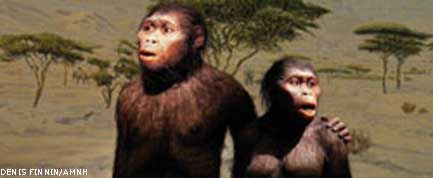Possible Link to Lucy's Ancestors Found

New jaw fossils might suggest a direct line of descent between two species of early humans, including the one to which "Lucy" belongs. The 3.2 million-year-old Lucy, the earliest known adult hominid, was found in Ethiopia in 1974 by U.S. paleontologists Donald Johanson and Tom Gray. Lucy and her kind, Australopithecus afarensis, stood upright and walked on two feet, though they might also have been agile tree-climbers. Anthropologists have suspected an ancestor-descendant relationship between the Lucy species and a predecessor--Australopithecus anamensis--based on their similarities but lacked fossils from an intervening period. Now, Australopithecus fossils found in the Woranso-Mille area of the Afar Region, Ethiopia, fill the date gap between A. anamensis (4.2 to 3.9 million years ago)—and the Lucy species (3.0 to 3.6 million years ago). The species identifications for all the bones remain uncertain, though it appears that some are A. afarensis. Yohannes Haile-Selassie, a physical anthropologist at the Cleveland Museum of Natural History, says his team's 2007 field season in the Woranso-Mille region uncovered the key evidence. "We recovered fossil hominids that date to between 3.5 and 3.8 million years ago," Haile-Selassie said in a prepared statement. "These specimens sample the right time to look into the relationship between Australopithecus anamensis and Australopithecus afarensis and will play a major role in testing the ancestor-descendant hypothesis." The team had found teeth from this time frame at the site over the past few years, but the new material includes more complete jaws that will enable better comparisons, he said.
"We have about 35 specimens, mostly isolated teeth, but including one partial skeleton which we believe will give us a lot of information on the post-cranial morphology of early human ancestors," Haile-Selassie told LiveScience.
At least 40 hominid specimens have been recovered from the site so far, including the complete jaws and the partial skeleton. The latter was found in 2005. The team started work in the Woranso-Mille region in 2004 and quickly started finding fossils of early hominids as old as 3.7 million years old, Haile-Selassie said.
"We were sure of their importance," he said, "because we knew right from the beginning how old these bones were. We used what is called biostratigraphy to estimate the age of the fossils. Now, we have radiometric dates from volcanic rocks that we sampled from the study area, and now we have a minimum age of 3.5 million years and a maximum of 3.8 million years."
Ethiopia, Kenya and Tanzania have yielded many of the earliest hominid and ape fossils that have allowed anthropologists to piece together the history of human evolution.
- Top 10 Missing Links
- Top 10 Intelligent Designs
- All About Evolution
Sign up for the Live Science daily newsletter now
Get the world’s most fascinating discoveries delivered straight to your inbox.
Robin Lloyd was a senior editor at Space.com and Live Science from 2007 to 2009. She holds a B.A. degree in sociology from Smith College and a Ph.D. and M.A. degree in sociology from the University of California at Santa Barbara. She is currently a freelance science writer based in New York City and a contributing editor at Scientific American, as well as an adjunct professor at New York University's Science, Health and Environmental Reporting Program.












